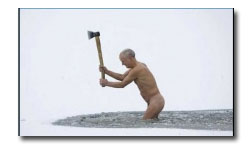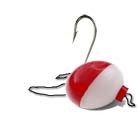Before You Go Ice Fishing
By Derek Webb

Ice Fishing Prep
__________________________________________________________________
If it is your first time ice fishing (first off congrats and best of luck) or you just need some tips here are some must knows in order to have a successful trip. Now the first and most important thing is safety. Remember that you are most likely going to be some distance from help so make sure to plan accordingly. Make sure to bring a first aid kit, a source of light, appropriate clothes and shoes (grippers are the best), plenty of liquids and food and I find some rope comes in handy as well (if not just for peace of mind). If you want to a list of other safety devices we recommend click here.
Now I’m well aware that the easiest way to catch a fish is to have someone throw one to you, but with some know how you will a lot of times have a better trip (numbers wise) than in the spring and summer. The first thing you need (obviously) is an ice fishing rod. They are those short ones you see in stores for a few months a year (kids they make great swords to play with). Now you can spend some money on a very nice rod but I agree that, especially if you’re only going a few times a year, to get an inexpensive one. You usually can find a good one with a reel for fewer than twenty dollars. Another option for the lazy is a stand up which is a set up that sits by the hole and sets up a flag if a fish bites. I personally haven’t had any success with these but I have seen it be very successful.
Next you will need something to sit on. You can always go with the cliché white bucket but I recommend something that is easy to carry and consists of as little metal as possible (cold metal isn’t very comfortable). Now for the lucky and dedicated there are ice fishing shelters. These portable dwellings come in a variety of sizes and are great when weather is an issue, and the consensus here is that wind blows. Bring along a portable heater and TV and your set. I also suggest getting a sled to carry all the awkward heavy stuff. A cheap plastic one for the kids does just fine.
I cannot stress how important it is to have a tool made to make holes, like an auger (sorry jackhammers are not recommended). I have witnessed people using various items to make holes, and as entertaining as it is, if you don’t have one make friends with someone who does. It’s a great way to get to know your neighbors. Also have a utensil that removes ice that forms in the holes, they are cheap and extremely useful. A noodle strainer works if you don’t have one.
Now before you step on the ice make sure that you are comfortable with how thick the ice is and the temperature it is going to be while you’re there. It’s not worth it if you have your doubts. A good rule of ice thickness is at least 6 inches, the more the better. Also avoid any open water you see, I actually won’t go on a lake that has any spots of open water (Thank you Peter Benchley). A good idea is to see where other people are fishing and find a spot where you can see each other (catching a big fish with an audience is better). In states that require it get the extra rod stamp so you can have an extra hole, it is worth it, and yes Park Rangers can count. However do drill extra holes around where you are about twenty feet away (I like three) so if you aren’t on the fish you don’t have to crank out the auger again. Also I recommend you space your holes at least 18 inches apart and as common sense tells us to make a reasonable size hole that you can’t fit in (most states have size restrictions).

Not a recommended way.
As for tackle we need to remember two things. First is the fact, which I have yet to confirm, that says that fish are cold blooded meaning that they don’t move around all that much. The second thing I’ve been told is that food is scarce in the winter, which bodes well for us. So first you need to find your unsuspecting prey. The same rules apply in winter so look for areas that are deep (20-50ft is average) and have some sort of fish shelter (like points jutting into the lake). To find the fish the best way is with a fish finder (you can rig a cheap stand for the one on your boat if you’re comfortable with it). A test hole and a fish finder is a great way to early success. If you don’t look for old ice holes, there is a reason that someone decided to fish there. And of course you can look up the fishing report for tips or you can be sneaky and see who has caught a fish while you’ve been packing up your stuff and head off in their direction.
Now to set up your pole make sure you have a depth finder. It is a small metal ball that you clamp onto the end of your line (usually a bright color like orange). Once your hole is made you need to find out how deep. You attach the depth finder to your line and then you let it drop down into the water. Let out the slack slowly until it stops (usually it’s the bottom). Taking a step back you want to first put on a hollow tubed bobber that doesn’t clamp to the line (there are Styrofoam ones as well)to your line with a line marker in front of it. When you’re finding the depth of the hole you want to move the marker up the line keeping it above the water line until you find the bottom. If you’ve done it right the bobber should be right behind the marker. When you first reel in after about 6 to 24 inches and move the marker to the depth you want and from now on the bobber will float the line that much above the floor where the fish are. Clamp on a small amount of weight to keep the line straight a few feet above the hook and your pole is ready.
Now for the bait. It always depends on the species you are after but a staple is meal worms and minnows. You can use lures but I don’t recommend using them your first time (unless you’re bored)due to the attention it takes) A few tips are that smell definitely plays a bigger role the deeper you go. Also I have learned is that you shouldn’t go with big hooks. It is easier to hook fish with smaller hooks (remember they aren’t moving all that fast). I recommend using hooks designed for ice fishing because the angle is different and many of them come in glow in the dark colors (I haven’t come to a conclusion on whether or not they are a good thing) There will be posts in the future with specific recommendations
There are some devices that are designed to increase your success. Click here to visit the article.
Now the fishing begins. I suggest moving your bait around slowly every so often to try to draw attention to it (also gives you something to do). Also the ice does make noise, so unless it’s a cracking noise don’t freak out.
Best of luck on the ice and remember it can be a dangerous hobby, so be safe. And as always, beer is optional (and only if you’re not driving).
If you have any suggestions or tips please post them below..


